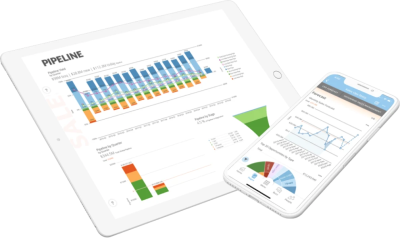Nine reasons why dashboard design is essential
Dashboards are a type of business intelligence tool that enables businesses to make use of data and guide decisions within the company.
Instead of needing highly skilled teams of data analysts to extract findings from data and present them to the rest of the company—for example, as a report—dashboards allow data insights to be gathered and displayed as easy-to-understand visualizations almost instantly by anyone.
Often, these data insights can be displayed in close to real time as the data updates. At the very least, these insights are conveyed more quickly than when using traditional methods of data analysis and reporting and, often, more accurately.
However, a crucial part of using dashboards to their full potential—and to guide the best possible decisions for a business—is executing an effective dashboard design. A good dashboard clearly illustrates the picture of performance demonstrated by the data and highlights the most important information.
Here are nine reasons why.

It prevents data from being misinterpreted.
The key to great dashboard design is clarity.
After all, the purpose of a dashboard is to take insights from vast, varied datasets across an array of sources and transform these insights into visualizations that can be understood by anyone.
Without the help of a dashboard with a well-executed dashboard design, it would be easy to miss or misinterpret findings from data since trends would be hidden in the poor design.
In addition, a host of dashboard design mistakes can lead to the user misinterpreting data findings, such as using visualizations that unintentionally mislead the viewer.
For example, a certain type of visualization may exaggerate the significance of some data, while failing to provide context—such as historical data—can leave the viewer in the dark about whether a KPI is performing well or not.
With good knowledge of how to effectively use different kinds of data visualization and how to organize data in a clear way, dashboard designers can ensure that their dashboards don’t accidentally mislead.
It eliminates guesswork and facilitates data-driven decisions.
Individuals at every level, from frontline employees to high-level executives, can benefit from insights revealed by data gathered about their performance.
However, not everyone is a data analyst. So, these insights are largely inaccessible without the help of business intelligence tools such as dashboards.
Of course, a frontline worker is going to have very different data needs from an executive. Dashboards need to have a clear goal and be designed specifically to meet that goal. This way, viewers can actually use them for insight during their day-to-day operations.
A dashboard design that has a clear goal and that fully understands the problem it is being designed to solve—as well as the needs of the end user—ensures that the resulting dashboard is geared towards achieving that end, displaying data findings in a way that allows the user to make the best informed decisions to achieve their goals.
It allows decisions to be made rapidly.
In the past, teams of data analysts were used to illuminate findings from data by manually collecting, aggregating, and analyzing the data for insight that could be used to further the success of the company.
However, most of these insights would take time to uncover, meaning that time is wasted before decision-makers can take action. That means data analysis is the bottleneck for every business decision. Often, that means decision makers either have to wait or make their decisions without data to back them up.
With modern, real-time dashboards, there’s a quicker turnaround, so that decision-makers can solve problems and implement new strategies much more quickly.
Another cornerstone of effective dashboard design is that the ‘big picture’ shown by the data can be perceived within 5 seconds of viewing the dashboard. This means that, when there are new trends and implications, they can be spotted immediately.
This is especially important for aspects of a business tracked by operational dashboards. Users can track their metrics and see changes as they occur, and respond to those changes in a rapid, agile way.

It allows the most important metrics to be highlighted.
Poorly executed dashboard design results in data visualizations being thoughtlessly positioned on the dashboard, so the most important key performance indicators (KPIs) and visualizations may escape notice.
When the order and position of the dashboard visualizations aren’t thought out, the most important findings and insights presented by the data are hard to locate, and the overarching story told by the data isn’t clear.
Thoughtful dashboard design enables you to frame the most important metrics so they stand out to the viewer, making them more likely to stick in their mind and guide future decisions.
It allows the story presented by data to be conveyed clearly.
With thought and care put into the order, size, and position of their metrics, dashboard builders can tell stories with their data, leading viewers to clear implications.
When dashboard design is executed well, you can use the order of the visualizations to highlight the comprehensive picture conveyed by the data. By using dashboard design theory, designers can predict how a user will scan the dashboard and place their data visualizations accordingly.
Storytelling is the most effective way to make something memorable. So, dashboard storytelling can help to impress data findings onto the end users’ memory and guide their decisions going forward. Data storytelling is especially useful for presentations where you want viewers to be convinced of a certain point of view.
Effectively conveying the entire picture presented by the data allows decision-makers to make fully contextualized choices. Fully informed, data-driven decisions give businesses the greatest opportunity to achieve their goals.
It gives more context.
Effectively designed dashboards will present the most important metrics for guiding decisions and not overload the dashboard.
However, sometimes it’s necessary to look at the underlying data supporting these visualizations, or to view related metrics for greater context.
For this reason, designing dashboards so that users can access these data sets is a good idea. This allows users to drill down for additional insight, get more context, or just figure out where the data is coming from.

It encourages investors.
If the end user for your dashboard is investors—either people who are considering investing in your company or who have already made an investment—then effective dashboard design can improve their confidence in your business’s competency.
Dashboard design plays a huge role in ensuring that the key findings revealed by the data are clear and easy to understand. This is crucial when investors, who don’t know the ins and outs of your business, are the end users.
This gives investors peace of mind when supporting your business and helps to convince them to dedicate more resources to your operations. Good dashboard design can enhance investors’ belief in your business’s capabilities and its ability to achieve its goals.
It unifies teams and departments towards a goal.
Dashboards are great tools for clarifying objectives and making sure that everyone is working towards the same goal. With broad, team-wide dashboards, anyone and everyone can draw insight from them and drive further success.
The dashboard design process begins with determining the goal of the dashboard, including the specific business objective it seeks to achieve and who’s going to be using it. Dashboard design should be tailored to best meet the needs of the end user and help them reach their goals.
With a set of dashboards that clearly communicate their progress towards their goals, teams can collaborate towards that progress much more efficiently. Dashboards help to keep everyone on the same page and working towards the same goals.
It allows you to track success.
With dashboards, businesses can track their key indicators of success. This way, they can know whether or not they’re succeeding as they implement new strategies and face new business challenges.
When dashboard designers do their job right, users can see their KPIs in clear, effective ways. This is crucial as it allows businesses to alter or terminate strategies that aren’t working right, and gives more context as to why they aren’t.
Effective dashboard design also highlights when a strategy is working. This way, businesses can know their most effective strategies, and allocate more resources towards the ones that garner the most wins.
The bottom line
Businesses can’t use dashboards to drive insight or make decisions unless they know how to design them effectively. Badly made dashboards don’t help with data insight, don’t help businesses track their key metrics, and can often mislead viewers.
Any BI user who’s going to be building or editing dashboards needs to know dashboard design strategies and best practices. Without that training, there’s no way that businesses can use their BI tool to drive success and win business.
Check out some related resources:

The 11 Best Big Data Analytics Tools in 2025

Guide to ETL Data Modeling: Process, Techniques, and Best Practices






